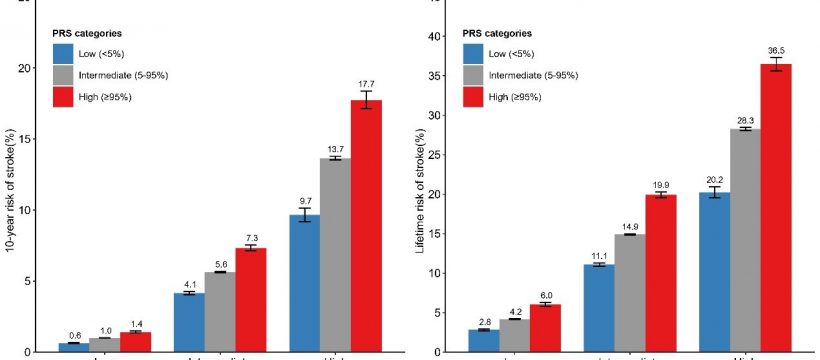
Using a stroke PRS for East Asian populations comprising 534 genetic variants associated with stroke or stroke-related traits identified from large-scale genome-wide association studies (GWASs), Xiangfeng Lu and Dongfeng Gu from Fuwai hospital, Chinese Academy of Medical Sciences & Peking Union Medical College investigated the risk prediction and stratification for the PRS when integrating with a clinical risk score in Chinese large prospective cohorts comprising 41,006 individuals aged 30-75 years with a mean follow-up of 9.0 years.
They carried out analyses to estimate the 10-year and lifetime risk of stroke according to joint categories of polygenic and clinical risk. Within each clinical risk category, marked gradients in the 10-year and lifetime risks across PRS categories were observed, indicating the potential of PRS to improve risk stratification. In particular, among individuals at intermediate clinical risk with uncertainty for prevention recommendations, a high PRS (top 5%) may shift 10-year risk (7.3%, 95%CI 7.1%–7.5%) into high clinical risk category.
“Adding the PRS to clinical risk score offers valuable guidance for clinical decision-making, especially when there is clinical uncertainty. For example, in middle-aged subjects with moderate risk factor levels, those with high PRS could be distinguished for initiating targeted prevention,” Lu says.
The researchers also test the ability of the PRS to identify potential high-risk individuals among individuals with intermediate clinical risk in various age groups. For individuals aged ≥50 and ≥60 years, those in the top 10% and 20% of the PRS also meet high clinical risk level, indicating the cut-off points for high PRS can be a bit lower.

“These new exciting results provide evidence that stroke polygenic risk was not well captured by traditional clinical risk. The combination of polygenic and clinical risk is expected to enhance precision prevention of stroke and reduce the disease burden, particularly considering the low awareness, treatment, and control rates of clinical risk factors. We hope that this study will encourage scientists to further investigate the cost-effectiveness of implementing PRS to individuals at intermediate clinical risk in a clinical trial,” Gu says.
Evidence regarding the incorporation of both stroke polygenic and clinical risks to improve prevention efforts was limited. Rather, the improvement in predictive accuracy of genetic information over traditional risk algorithms is generally modest. These new data implicated the value of PRS to enhance precision prevention, and lay the foundation for future efforts to examine the utility of PRS in other populations.
The research is published in the journal Science China Life Sciences.
More information:
Qingmei Cui et al, Integrating polygenic and clinical risks to improve stroke risk stratification in prospective Chinese cohorts, Science China Life Sciences (2023). DOI: 10.1007/s11427-022-2280-3
Journal information:
Science China Life Sciences
Source: Read Full Article
